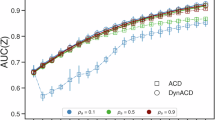Abstract
The identification of anomalous user behaviour is important in a number of application areas, since it may be indicative of fraudulent activity. In the work presented here, the focus is on the identification and subsequent investigation of suspicious interactions in a network of financial transactions. A network is constructed from data from a peer-to-peer lending system, with links between members representing the initiation of loans. The network is time-sliced to facilitate temporal analysis. Anomalous network structure is sought in the time-sliced network, illustrating the occurrences of unusual behaviour among members. In order to assess the significance of the dense structures returned the enrichment of member attributes within these structures is examined. It seems that dense structures are associated with geographic regions.
This work is supported by Science Foundation Ireland under Grant No. 08/SRC/I1407.
Access this chapter
Tax calculation will be finalised at checkout
Purchases are for personal use only
Preview
Unable to display preview. Download preview PDF.
Similar content being viewed by others
References
Garey, M.R., Johnson, D.S.: Computers and Intractability: A Guide to the Theory of NP-Completeness. W. H. Freeman & Co., New York (1979)
Subelj, L., Furlan, S., Bajec, M.: An expert system for detecting automobile insurance fraud using social network analysis. Expert Systems with Applications 38(1), 1039–1052 (2011)
Wan-Shiou Yang, S.Y.H.: A process-mining framework for the detection of healthcare fraud and abuse. Expert Syst. Appl., 56–68 (2006)
Ratkiewicz, J., Conover, M., Meiss, M., Gonçalves, B., Patil, S., Flammini, A., Menczer, F.: Truthy: mapping the spread of astroturf in microblog streams. In: Proceedings of the 20th International Conference Companion on World Wide Web (WWW 2011), pp. 249–252. ACM (2011)
Morselli, C., Giguère, C., Petit, K.: The efficiency/security trade-off in criminal networks. Social Networks 29(1), 143–153 (2007)
Reuter, P., Truman, E.M.: Chasing Dirty Money: The Fight Against Money Laundering. Peterson Institute (2004)
Cortes, C., Pregibon, D., Volinsky, C.: Communities of Interest. In: Hoffmann, F., Adams, N., Fisher, D., Guimarães, G., Hand, D.J. (eds.) IDA 2001. LNCS, vol. 2189, pp. 105–114. Springer, Heidelberg (2001)
Pandit, S., Chau, D.H., Wang, S., Faloutsos, C.: NetProbe: A Fast and Scalable System for Fraud Detection in Online Auction Networks. In: Proceedings of the 16th International Conference on World Wide Web (2007)
Fortunato, S.: Community Detection in Graphs. Physics Reports 486(3-5), 75–174 (2010)
Bron, C., Kerbosch, J.: Algorithm 457: Finding All Cliques of an Undirected Graph. Communications of the ACM 16(9), 575–577 (1971)
Seidman, S., Foster, B.: A Graph-Theoretic Generalization of the Clique Concept. Journal of Mathematical Sociology 6, 139–154 (1978)
Seidman, S.: Network Structure and Minimum Degree. Social Networks 5(3), 269–287 (1983)
Cohen, J.: Graph Twiddling in a MapReduce World. IEEE Computing in Science & Engineering 11(4), 29–41 (2009)
Cohen, J.: Trusses: Cohesive Subgraphs for Social Network Analysis. Technical report, National Security Agency (2008)
Holme, P., Saramäki, J.: Temporal networks. CoRR abs/1108.1780 (2011)
Vanetik, N., Gudes, E., Shimony, S.E.: Computing Frequent Graph Patterns from Semistructured Data. In: Proceedings of the International Conference on Data Minning, pp. 458–465 (2002)
Kuramochi, M., Karypis, G.: Grew: A Scalable Frequent Subgraph Discovery Algorithm. In: Proceedings of the IEEE International Conference on Data Mining (2004)
Kuramochi, M., Karypis, G.: Finding Frequent Patterns in a Large Sparse Graph. Data Mining and Knowledge Discovery 11, 243–271 (2005)
Yan, X., Yu, P., Han, J.: Graph Indexing: A Frequent Structure-Based Approach. In: Proceedings of the ACM SIGMOD International Conference on Management of Data, pp. 335–346 (2004)
Cheng, J., Ke, Y., Ng, W., Lu, A.: FG-Index: Towards Verification-Free Query Processing on Graph Databases. In: Proceedings of the ACM SIGMOD International Conference on Management of Data, pp. 857–872 (2007)
Xiong, L., Liu, L.: A reputation-based trust model for peer-to-peer ecommerce communities. In: Proceedings of the 4th ACM Conference on Electronic Commerce (EC 2003), pp. 228–229. ACM (2003)
Python Software Foundation: Python (2012), http://www.python.org
NetworkX Developers: NetworkX (2010), networkx.lanl.gov
Hunter, J., Dale D., Droettboom M.: matplotlib (2011), matplotlib.sourceforge.net
Gephi: Gephi (2012), gephi.org
Rivals, I., Personnaz, L., Taing, L., Potier, M.: Enrichment or depletion of a GO category within a class of genes: which test? Bioinformatics 23(4), 401–407 (2007)
Author information
Authors and Affiliations
Editor information
Editors and Affiliations
Rights and permissions
Copyright information
© 2012 Springer-Verlag Berlin Heidelberg
About this paper
Cite this paper
Redmond, U., Harrigan, M., Cunningham, P. (2012). Mining Dense Structures to Uncover Anomalous Behaviour in Financial Network Data. In: Atzmueller, M., Chin, A., Helic, D., Hotho, A. (eds) Modeling and Mining Ubiquitous Social Media. MUSE MSM 2011 2011. Lecture Notes in Computer Science(), vol 7472. Springer, Berlin, Heidelberg. https://doi.org/10.1007/978-3-642-33684-3_4
Download citation
DOI: https://doi.org/10.1007/978-3-642-33684-3_4
Publisher Name: Springer, Berlin, Heidelberg
Print ISBN: 978-3-642-33683-6
Online ISBN: 978-3-642-33684-3
eBook Packages: Computer ScienceComputer Science (R0)




